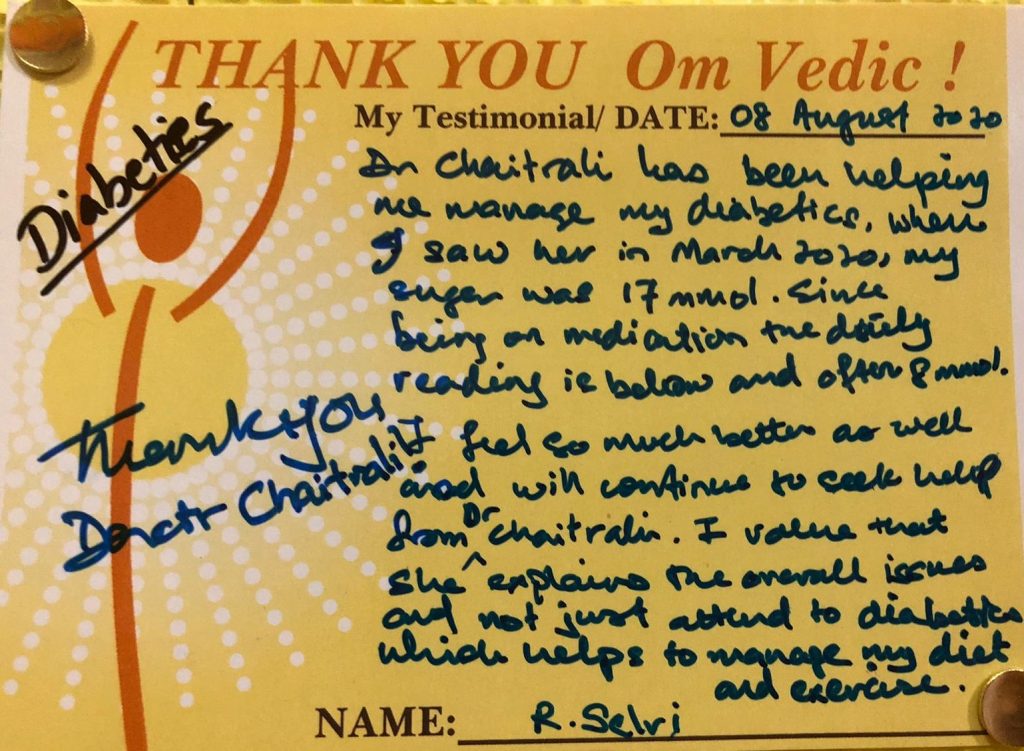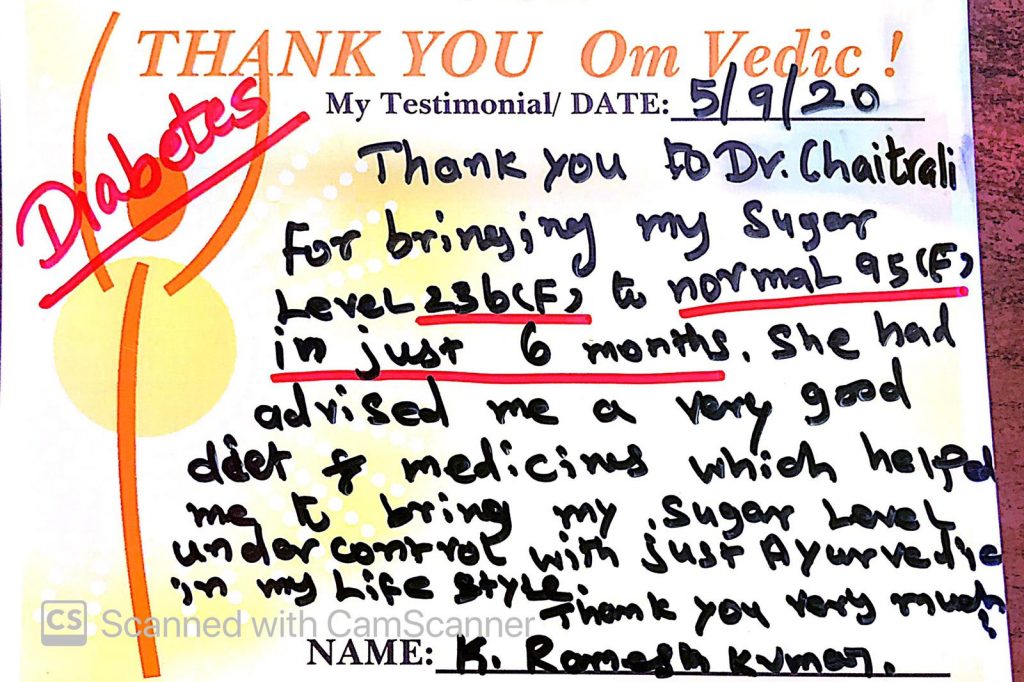TEST YOUR BLOOD SUGAR LEVEL AT OUR CENTRES FOR $2 ONLY

Ayurveda found the emergence of diabetes, back in 1000 BC (Charaka Samhita). All ways to manage diabetes is found in Ayurvedic literature. Diabetes Mellitus is a condition that hinders your body’s ability to respond to insulin, which eventually leads to abnormal metabolism of carbohydrates, leading to spiked blood sugar levels. Diabetes is one of the most common health conditions faced by millions across the world. Ayurveda expert Dr. Vasant Lad explains diabetes’ development as a result of the “diminished functioning of agni (digestive fire), which may trigger high blood sugar levels.

Diabetes can be co-related with Madhumeham (also called kshudra meha in ayurveda). Madhumeha is a combination of Madhu and Meha. Madhu means sweet and Meha means urine. According to Ayurveda, Madhumeha is a disease in which the patient passes urine more frequently and the urine is characterised as having astringent and sweet taste. Madhumeha is considered as one among the Ashtamahagada (eight major diseases which are difficult to cure)
Type 1 diabetes is described as an imbalance of the Vata (air and wind) dosha. Type 2 is an excess of the Kapha (water and earth) dosha. Vatika prameha is incurable (Asadya) so this one can correlate with Type 1 diabetes. Another classification is Sahaja (genetic) and Apathyanimittaja (due to life style). In this Sahaja also can correlate with Type 1 diabetes.
Types
- Kapha type (Divided into 10 types)
- Pitta type (Divided into 6 types)
- Vata type (Divided into 4 types)
Causes (Nidana)
- Lack of exercise
- Sleeping during the day
- Sedentary habits
- Consumption of food and liquids which are cold, unctuous, sweet and fatty.
Prodromal (the time between the appearance of initial symptoms and the full development of the disorder) Symptoms (Poorva Roopa)
- Sweda (Increased sweating)
- Angagandham (Foul smell from the body)
- Sayyasna swapnasukhabhishangithwam (Feeling of lethargy or tiredness all the time)
- Hridayopadeham (Heaviness of Heart)
- Netropadeham (Feeling of something coating the eyes)
- Anga ghanathwam (Heaviness of body parts)
- Gala shosham (Dryness of throat)
- Karadaham (Burning sensation of palms)
- Pada daham( Burning sensation of soles )
- Moothra madhuryam (Sweetness of urine)
Main symptoms
- Polyuria (Excessive Urine)
- Polyphagia (Excessive Hunger)
- Polydipsia (Excessive Thirst)
- Exhaustion/Tiredness
- Unexplained weight loss
- Numbness in the hands and feet
- Slow healing
- Sexual disorders
- Blurry vision
Treatment
Living with Diabetes is the toughest part. However, it is possible to treat Diabetes from aggravating using the formulas derived by our ancestors in Ancient Ayurveda. The treatment modalities are determined by the type and stage of disease.
Apatarpana chikitsa (detox) and santarpana chikitsa (rejuvenation)
In ayurveda, Diabetics (Prameha rogi) are classified as Obese (Sthula and Balavan) and Thin (Krisha). Treatment for obese Diabetics start with panchakarma which is called Apatarpana chikitsa. Kshina (lean diabetics) can undergo milder cleansing procedures followed by nourishing treatment (Santarpana chikitsa)
Diet for Diabetic patient
Diet and Exercise are the 2 key factors in treating Diabetes. It is very important that, if diagnosed with Diabetes you must change your diet and lifestyle. Food should be light and easily digestible and the person should maintain proper and disciplined diet timings.
Have a daily and a seasonal routine plotted and follow it. Excess intake of food is not allowed. Include green and leafy vegetables into the diet. It will enhance your nutritional status. Also, it regulates your body’s metabolism.
Grains that may be used: Wheat, Old rice, Navara rice, Barley, Kodrava (Paspolum scorbiculatum)
Pulses: Red gram, Horse gram, Green gram
Vegetables: Green banana, Asparagus, Fenugreek leaves( Methi), Bitter gourd ( Karela), Drum stick, Garlic, Broccoli, Spinach, Celery, Bean, Bell pepper, Coriander leaves, Radishes
Fruits: Amlaki, Jambu, Orange, Watermelon, Apples, Mango, Lime, Pineapples
Oils: Mustard, Sunflower
Single herbs useful: Bilva, Amra beeja, Karela, Jamun, Tulasi, Long pepper, Shilajit, Twak, Tejapatra
Here are a few home remedies that Dr Vasant lad’s book suggests: Mix one part of guduchi (Tinosporo cordifolia), a part of shardunika (Gymnema syvestre), a part of kudki (Picrorrhiza kurroa) and 2 parts of punarnava (Boerhavia diffusa) and mix them well into a diabetic-friendly herbal mixture. Drink this herbal mixture for two to three times a day and consume with warm water.
Ayurvedic formulations
- Nishakathakadi kashayam
- Katakakhadiradi kashyam
- Amritamehari choornam
- Nishamalaki choornam
- Gandhaka rasayana
Conclusion
There is no short cut to treating diabetes but, Ayurvedic Treatment increases the pace of bringing Diabetes under control. Make sure you maintain a balanced diet, lifestyle and take the prescribed herbal medicines. Ayurveda not only helps reduce blood sugar but also decreases the effects of the disease.
Disclaimer: All data provided in this website is to be used for information purposes only. The website’s content is not a substitute for direct, personal, professional medical care and diagnosis. Examples in these materials are not to be interpreted as a promise or guarantee. Customer testimonials as found on our Website are strictly the opinion of that person; your results may vary based upon your constitution or circumstances.

